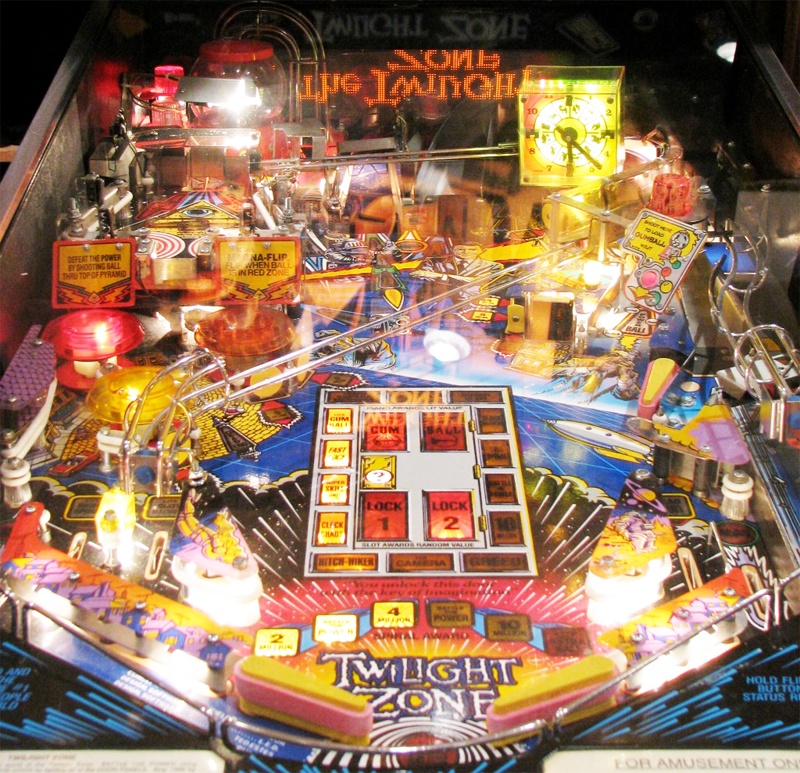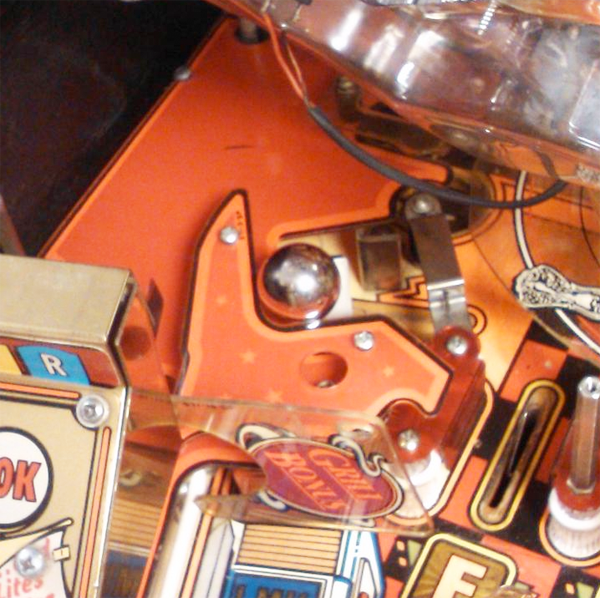Difference between revisions of "Design"
(→Space) |
|||
| Line 61: | Line 61: | ||
A game usually has to fit into a room, or fit through a door, so space is an important consideration. For example, here is a list of playfield sizes used by the manufacturers over the years, which is useful if repurposing an existing cabinet is part of the plan: | A game usually has to fit into a room, or fit through a door, so space is an important consideration. For example, here is a list of playfield sizes used by the manufacturers over the years, which is useful if repurposing an existing cabinet is part of the plan: | ||
| − | | | + | {|class="wikitable" style="border-width: 5px;" cellpadding="10" |
| − | + | !Manufacturer | |
| + | !Era | ||
| + | !Type | ||
| + | !Size | ||
|- | |- | ||
| − | |Atari|SS|Widebody|27.00" x 45.00" | + | |Atari |
| + | |SS | ||
| + | |Widebody | ||
| + | |27.00" x 45.00" | ||
|- | |- | ||
| − | |Bally|EM|Standard|20.25" x 41.00" | + | |Bally |
| + | |EM | ||
| + | |Standard | ||
| + | |20.25" x 41.00" | ||
|- | |- | ||
| − | |Bally|SS|Standard|20.25" x 42.00" | + | |Bally |
| + | |SS | ||
| + | |Standard | ||
| + | |20.25" x 42.00" | ||
|- | |- | ||
| − | |Bally|SS|Widebody|26.75" x 40.50" | + | |Bally |
| + | |SS | ||
| + | |Widebody | ||
| + | |26.75" x 40.50" | ||
|- | |- | ||
| − | |Capcom|SS|Standard|20.25" x 46.00" | + | |Capcom |
| + | |SS | ||
| + | |Standard | ||
| + | |20.25" x 46.00" | ||
|- | |- | ||
| − | |Data East|SS|Standard| 20.25" x 46.00" | + | |Data East |
| + | |SS | ||
| + | |Standard | ||
| + | |20.25" x 46.00" | ||
|- | |- | ||
| − | |Data East|SS|Widebody|25.00" x 51.75" | + | |Data East |
| + | |SS | ||
| + | |Widebody | ||
| + | |25.00" x 51.75" | ||
|- | |- | ||
| − | |Gottlieb|EM|Standard|20.25" x 41.00" | + | |Gottlieb |
| + | |EM | ||
| + | |Standard | ||
| + | |20.25" x 41.00" | ||
|- | |- | ||
| − | |Gottlieb|System 1|Standard|20.25" x 42.00" | + | |Gottlieb |
| + | |System 1 | ||
| + | |Standard | ||
| + | |20.25" x 42.00" | ||
|- | |- | ||
| − | |Gottlieb|System 80|Standard|23.75" x 46.50" | + | |Gottlieb |
| + | |System 80 | ||
| + | |Standard | ||
| + | |23.75" x 46.50" | ||
|- | |- | ||
| − | |Gottlieb|System 80 |Widebody|26.75" x 46.50" | + | |Gottlieb |
| + | |System 80 | ||
| + | |Widebody | ||
| + | |26.75" x 46.50" | ||
|- | |- | ||
| − | |Stern|SS|Widebody|23.875" x 45.00" | + | |Stern |
| + | |SS | ||
| + | |Widebody | ||
| + | |23.875" x 45.00" | ||
|- | |- | ||
| − | |Williams|System 1-11|Standard|20.25" x 42.00" | + | |Williams |
| + | |System 1-11 | ||
| + | |Standard | ||
| + | |20.25" x 42.00" | ||
|- | |- | ||
| − | |Williams|System 1-11|Widebody|27.00" x 42.00" | + | |Williams |
| + | |System 1-11 | ||
| + | |Widebody | ||
| + | |27.00" x 42.00" | ||
|- | |- | ||
| − | |WMS|WPC (through 1987)|Standard|20.50" x 42.00" | + | |WMS |
| + | |WPC (through 1987) | ||
| + | |Standard | ||
| + | |20.50" x 42.00" | ||
|- | |- | ||
| − | |WMS|WPC (1987 on)|Standard|20.50" x 46.00" | + | |WMS |
| + | |WPC (1987 on) | ||
| + | |Standard | ||
| + | |20.50" x 46.00" | ||
|- | |- | ||
| − | |WMS|WPC | + | |WMS |
| + | |WPC (1987 on) | ||
| + | |Superpin | ||
| + | |23.25" x 46.00" | ||
|- | |- | ||
| − | |WMS|WPC|Safecracker|16.50" x 41.50" | + | |WMS |
| + | |WPC | ||
| + | |Safecracker | ||
| + | |16.50" x 41.50" | ||
|- | |- | ||
| − | |WMS|Pinball 2000|Standard|20.50" x 43.00" | + | |WMS |
| + | |Pinball 2000 | ||
| + | |Standard | ||
| + | |20.50" x 43.00" | ||
|- | |- | ||
| − | |Zaccaria|SS|Standard|20.25" x 42.00" | + | |Zaccaria |
| + | |SS | ||
| + | |Standard | ||
| + | |20.25" x 42.00" | ||
|} | |} | ||
| − | |||
== Design Software == | == Design Software == | ||
Revision as of 20:36, 5 January 2015
Before anything else, you need to have a design you want to build.
Contents
Pinball Basics
Users of this site are assumed to have a basic understanding of what a pinball machine is and of the basic operation and maintenance of them, but for the purposes of designing one, a pinball machine generally consists of at least a minimum of a flat surface (generally plywood) for a steel ball to roll on, machine-controlled devices that interact with the ball such as switches or rubbers, and user-controlled devices to direct the ball, such as flippers.
Beyond that, the sky is the limit in terms of ideas and creativity. There are no rules that say you must use the "Two Flippers with In-lanes" standard that has been the convention since the 1960's. As a starting point, there are some standard layouts you can work from.
Layouts
If you need some inspiration, the modern machine layouts fall into two categories: Flow and Stop-and-Go.
Flow
For a game to be described as a Flow machine, the amount of time the ball is fully stopped without player interaction is kept at a bare minimum. This means outer loops that bring the ball back to the flippers quickly, allowing for looping, continuous shots.
An example of this type of game would be Attack From Mars', 1995 machine produced by WMS:
The game uses a Fan layout where all shots are direct lines from the flippers that mostly loop back to the flippers, allowing for quick and continuous ball action.
Stop and Go
For Stop and Go games, flipper shots can loop back to the flippers but many of the shots will involve scoops, ball traps and other devices that interrupt the flow of the ball, or cause delayed re-directions based on game rules.
An example of this type of game would be Twilight Zone, a 1993 machine also produced by WMS:
In this game, the majority of shots result in a ball stop or re-direction to a path not directly in line with the flippers.
It is up to the designer which style of pinball play they prefer when designing your game, and generally every designer has their own styles that are recognizable to regular players.
Themes
All pinball machines have a theme to help them differentiate from other machines or to attract players. Whether it is an original theme or based on an existing property, the theme you choose should help to inform the design of the game itself in some manner.
For a game to be used exclusively in a home, as most custom games will be, makers are free to choose whatever theme they find most appealing. If the game is intended for possible production for others, using an original theme is suggested to avoid any copyright or licensing issues.
Limitations
The important thing to remember when creating a pinball machine is that there are a number of key limitations that have to be understood and incorporated into a design to allow it to be physically produced.
Physics
Gravity only goes down. That means that a ball will only roll downhill unless there is a powered method of moving it otherwise. A designer has to be aware of all the possible ball traps where a ball might be prevented from rolling downwards - an example might be a ramp that drops a ball behind a post, or a ball guide that is not at a steep enough angle to allow the ball to roll without nudging the machine.
An example of a ball hangup, this ball is prevented from rolling by the decorative plastic covering above a hole where it ended up after the ball became airborne:
These sort of hangups usually show up in the whitewood stage but can often be predicted and avoided at the design stage.
Power
In the US and Canada, a single wall plug is restricted to 15-20A of available power. This should be considered the maximum available power to a game. Although at first glance it seems absurd that a design might exceed this amount, having multiple high current devices like coils, flash lamps, high power subwoofers and other power-hungry devices can eat up that power quickly. A design should take that into consideration.
Space
A game usually has to fit into a room, or fit through a door, so space is an important consideration. For example, here is a list of playfield sizes used by the manufacturers over the years, which is useful if repurposing an existing cabinet is part of the plan:
| Manufacturer | Era | Type | Size |
|---|---|---|---|
| Atari | SS | Widebody | 27.00" x 45.00" |
| Bally | EM | Standard | 20.25" x 41.00" |
| Bally | SS | Standard | 20.25" x 42.00" |
| Bally | SS | Widebody | 26.75" x 40.50" |
| Capcom | SS | Standard | 20.25" x 46.00" |
| Data East | SS | Standard | 20.25" x 46.00" |
| Data East | SS | Widebody | 25.00" x 51.75" |
| Gottlieb | EM | Standard | 20.25" x 41.00" |
| Gottlieb | System 1 | Standard | 20.25" x 42.00" |
| Gottlieb | System 80 | Standard | 23.75" x 46.50" |
| Gottlieb | System 80 | Widebody | 26.75" x 46.50" |
| Stern | SS | Widebody | 23.875" x 45.00" |
| Williams | System 1-11 | Standard | 20.25" x 42.00" |
| Williams | System 1-11 | Widebody | 27.00" x 42.00" |
| WMS | WPC (through 1987) | Standard | 20.50" x 42.00" |
| WMS | WPC (1987 on) | Standard | 20.50" x 46.00" |
| WMS | WPC (1987 on) | Superpin | 23.25" x 46.00" |
| WMS | WPC | Safecracker | 16.50" x 41.50" |
| WMS | Pinball 2000 | Standard | 20.50" x 43.00" |
| Zaccaria | SS | Standard | 20.25" x 42.00" |



